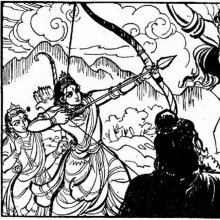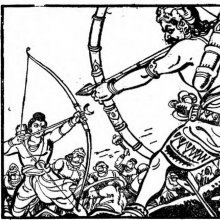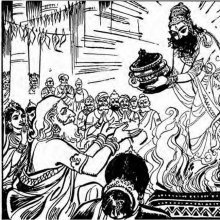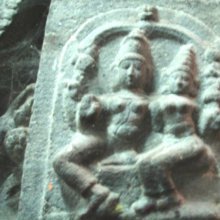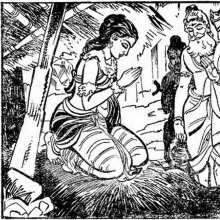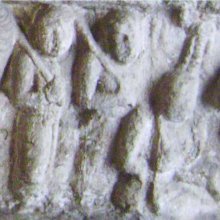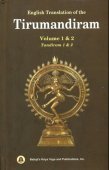Sacrifice: 2 definitions
Introduction:
Sacrifice means something in Hinduism, Sanskrit. If you want to know the exact meaning, history, etymology or English translation of this term then check out the descriptions on this page. Add your comment or reference to a book if you want to contribute to this summary article.
Images (photo gallery)
(+18 more images available)
In Hinduism
Natyashastra (theatrics and dramaturgy)
Source: Shodhganga: Elements of Art and Architecture in the Trtiyakhanda of the Visnudharmottarapurana (natya)Sacrifices are associated with Kapittha-hasta: one of the twenty-two Single-hand Gestures (in Indian Dramas) (known as asaṃyuktahastas), according to the Viṣṇudharmottarapurāṇa, an ancient Sanskrit text which (being encyclopedic in nature) deals with a variety of cultural topics such as arts, architecture, music, grammar and astronomy.—In the Śabdakalpadruma, the word kapittha is explained as a kind of tree where kapi i.e., monkey comes due to the greed of fruit. The word kapittha again denotes the fruit called wood apple. [...] This posture is used to denote sacrifice, holding of an umbrella or a garland or rope, dragging and fanning.

Natyashastra (नाट्यशास्त्र, nāṭyaśāstra) refers to both the ancient Indian tradition (shastra) of performing arts, (natya—theatrics, drama, dance, music), as well as the name of a Sanskrit work dealing with these subjects. It also teaches the rules for composing Dramatic plays (nataka), construction and performance of Theater, and Poetic works (kavya).
Vastushastra (architecture)
Source: Shodhganga: Elements of Art and Architecture in the Trtiyakhanda of the Visnudharmottarapurana (vastu)Sacrifices (undertaken for worshiping a deity) are included in the Antarvedi type of Devatāpūjana (“the worship of god”), according to the Viṣṇudharmottarapurāṇa, an ancient Sanskrit text which (being encyclopedic in nature) deals with a variety of cultural topics such as arts, architecture, music, grammar and astronomy.—In the Viṣṇudharmottarapurāṇa, devatāpūjana i.e., the worship of god is highly recommended to attain the supreme happiness and the book suggests two ways of worship in this context-one is antarvedi and another is bahirvedi. The sacrifices undertaken for worshiping a deity were associated with the procedure called antarvedi and other procedures like upavāsa, vrata etc. were recognized as the procedure of bahirvedi type of worship. Both these procedures of worship are seen to be practised in Hinduism. These procedures may be at the bottom of the idea of temple building.

Vastushastra (वास्तुशास्त्र, vāstuśāstra) refers to the ancient Indian science (shastra) of architecture (vastu), dealing with topics such architecture, sculpture, town-building, fort building and various other constructions. Vastu also deals with the philosophy of the architectural relation with the cosmic universe.
See also (Relevant definitions)
Partial matches: Sacrifice, Te.
Query error!
Full-text (+4131): Ashvamedha, Yajna, Devayajna, Yajana, Adhvara, Medha, Vajapeya, Ishti, Yaga, Adhiyajna, Bali, Rajasuya, Kratu, Yajamana, Homa, Caturmasya, Brahmayajna, Yajniya, Adhvaryu, Gomedha.
Relevant text
Search found 465 books and stories containing Sacrifice, Sacrifices, The sacrifice; (plurals include: Sacrifices, Sacrificeses, The sacrifices). You can also click to the full overview containing English textual excerpts. Below are direct links for the most relevant articles:
Manusmriti with the Commentary of Medhatithi (by Ganganatha Jha)
Verse 4.21 < [Section IV - The ‘Five Sacrifices’]
Verse 4.26 < [Section VI - The Harvest-Sacrifice]
Verse 3.70 < [Section VII - Duties of the Householder]
Brahma Sutras (Ramanuja) (by George Thibaut)
Sutra 3.3.59 < [Third Adhyaya, Third Pada]
Sutra 3.3.63 < [Third Adhyaya, Third Pada]
Sutra 3.3.64 < [Third Adhyaya, Third Pada]
Brahma Purana (critical study) (by Surabhi H. Trivedi)
9. The concept of Sacrifice < [Religion]
4. Varna system (d): Sudras < [Social Structure]
4. Varna system (c): Vaisyas < [Social Structure]
The Sacrifices of Rajasuya, Vajapeya and Ashvamedha (study) (by Aparna Dhar)
Summary of the Soma Sacrifice / Agniṣṭoma < [Chapter 2 - Vedic Sacrifices described in the Śatapatha Brāhmaṇa]
Significance of Sacrifice < [Chapter 2 - Vedic Sacrifices described in the Śatapatha Brāhmaṇa]
Chandogya Upanishad (english Translation) (by Swami Lokeswarananda)
Jnaneshwari (Bhavartha Dipika) (by Ramchandra Keshav Bhagwat)
Verse 4.28 < [Chapter 4 - Brahma-yajna]
Verse 3.14-15 < [Chapter 3 - Karma-yoga]
Verse 4.33 < [Chapter 4 - Brahma-yajna]
Related products
(+1 more products available)
